The central nervous system is composed of the brain and spinal cord. The peripheral nervous system is composed of the cranial and spinal nerves. The peripheral nervous system connects the body organs and skeletal muscles to the brain.
The peripheral nervous system is composed of somatic and autonomic systems. The skeletal muscles are controlled by the somatic nervous system and are controlled voluntarily. The internal organs and body processes, such as heart rate and digestion, are controlled by the autonomic nervous system and are involuntary.
The autonomic nervous system is divided into the sympathetic and parasympathetic systems. The sympathetic system responds to emergency situations. The parasympathetic system maintains homeostasis and normal body functions.
Similarities:
Cranial and spinal nerves are paired and present on both sides of the body. There are twelve pairs of cranial nerves and 31 pairs of spinal nerves. One nerve of each pair controls functions on one side of the body. The other nerve of each pair controls the same functions on the other side of the body.
The central nervous system communicates with the rest of the body through the cranial and spinal nerves.
Difference:
All spinal nerves are mixed nerves which carry sensory, motor and autonomic impulses between the spinal cord and the body. Some cranial nerves are purely sensory, some are purely motor and some are both sensory and motor.
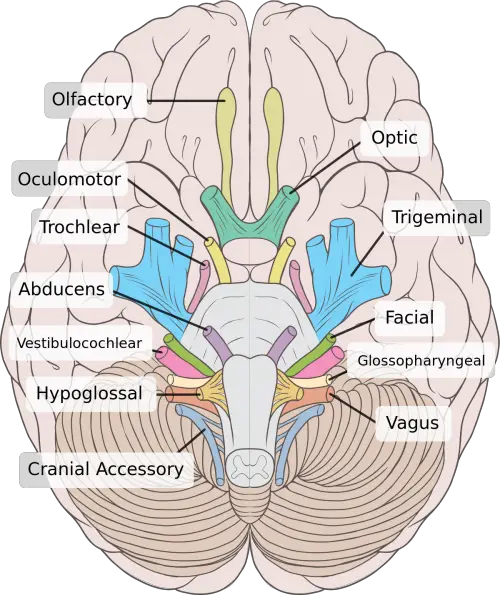
Cranial nerves:
Cranial nerves are associated with the head and neck, with the exception of Vagus Nerve X.
Cranial nerves are designated by name and Roman numeral. They are numbered in order, as they emerge from the brain, front to back, or ventral to dorsal.
The five mixed cranial nerves contain sensory, motor and parasympathetic autonomic nervous system fibers.
Cranial nerves are attached to the brain at irregular intervals.
| Cranial nerve | Sensory, motor or mixed | Function |
| Olfactory nerve I | Sensory | Olfaction |
| Optic nerve II | Sensory | Vision |
| Oculomotor nerve III | Mixed | Eye movement |
| Trochlear nerve IV | Motor | Eye movement: superior oblique muscle |
| Trigeminal nerve V | Mixed | Mastication |
| Abducens nerve VI | Motor | Moves eye laterally: lateral rectus muscle (abducts the eye) |
| Facial nerve VII | Mixed | Facial expression |
| Vestibulocochlear nerve VIII | Sensory | Audition |
| Glossopharyngeal nerve IX | Mixed | taste on posterior 1/3 of tongue (bitter) gag reflex |
| Vagus nerve X | Mixed | slows heart rate |
| Accessory nerve XI | Motor | Shrugs shoulders: trapezius muscle |
| Hypoglossal nerve XII | Motor | Tongue movement |
Five cranial nerves provide parasympathetic autonomic functions.
| Cranial nerve | Parasympathetic function |
| Oculomotor nerve III | Constricts pupil |
| Facial nerve VII | Salivary glands |
| Glossopharyngeal nerve IX | Parotid salivary gland
|
| Vagus nerve X | Heart and lungs |
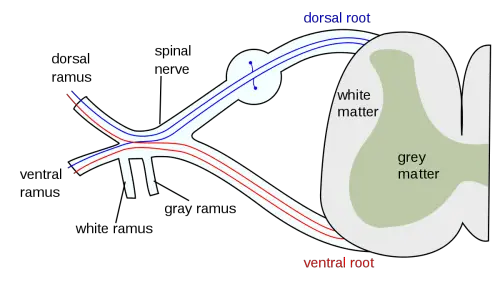
Spinal nerves:
8 cervical (C1-C8)
12 thoracic (T1-T12)
5 lumbar (L1-L5)
5 sacral (S1-S5)
1 coccygeal (Co1)
Peripheral nerve fibers originate in organs and bring sensory impulses from those organs to the sensory neurons in the dorsal root of the spinal nerve at the corresponding level of the spinal cord.
Motor impulses are transmitted from the spinal cord through the motor fibers in the ventral roots to skeletal muscles.
Dorsal roots carry afferent, sensory impulses. Ventral roots carry efferent, motor impulses.
Dorsal and ventral roots join to form a spinal nerve.
Spinal nerves bifurcate into dorsal rami, serving the dorsal part of the body and ventral rami, which form the nerves serving the ventral part of the body. The dorsal rami are much smaller than the ventral rami.
Spinal nerves are mixed nerves carrying impulses to and from the same organ.
Spinal nerve plexuses
Spinal nerves join together to form four major nerve plexuses, or collections of nerve fibers. The nerve fibers appear to be tangled and mostly serve the limbs. Each plexus is a network of nerve fibers that come together and redistribute. Each plexus contains fibers from several spinal nerves. The result is that each skeletal muscle receives impulses from several spinal nerves. Thus, if one nerve is injured, the other nerve fibers in the plexus can compensate.
Cervical plexus: contains the phrenic nerve (C3, C4, and C5) which innervates the diaphragm.
Breathing stops if the spinal cord is severed above C3.
Brachial plexus: contains the musculocutaneous, median, ulnar, radial and axillary nerves which innervate the muscles of the arms.
Lumbar plexus: contains the femoral nerve, which innervates the quadriceps femoris muscle of the anterior thigh.
Sacral plexus: contains the sciatic nerve, the largest nerve in the body, which is composed of the tibial nerve and the common fibular or peroneal nerve. The tibial nerve innervates the posterior thigh, leg and foot. The common fibular nerve innervates the anterolateral leg.
Thoracic nerves: The thoracic nerves, T2-T12, do not form a plexus, instead, the ventral rami form the intercostal nerves, which travel along the rib at the level of the spinal cord from which they exit.
| Plexus | Serves | Nerves | Nerve |
| Cervical | Head, neck and shoulders | C1-C5 | Phrenic (C3-5) diaphragm |
| Brachial | Chest, arms and hands | C5-T1 | |
| Lumbar | Back, abdomen, groin, thighs, knees and calves | L1-L4 | |
| Sacral | Pelvis, buttocks, genitals and feet | L4, L5, S1-S4 |
Summary
Cranial nerves can be sensory, motor or mixed. Spinal nerves are always mixed.
Cranial nerves emerge from the brain at irregular intervals and are numbered from front to back in Roman numerals.
Spinal nerves emerge from the spinal cord in regular intervals between vertebra from and are numbered in Arabic numerals from the top to the bottom in five regional areas: cervical, thoracic, lumbar, sacral and coccygeal.
Sensory impulses travel toward the central nervous system in afferent nerves.
Motor impulses travel away from the central nervous system in efferent nerves.
In spinal nerves, dorsal roots are sensory and afferent, and ventral roots are motor and efferent.
Cranial nerves emerge from the brain and control the head and neck with the exception of the Vagus Nerve X. Spinal nerves emerge from the spinal cord and control the body.
There are 12 pairs of cranial nerves and 31 pairs of spinal nerves.
There are four major spinal nerve plexuses.
Cranial nerves are usually named by function (olfactory nerve I). Spinal nerves are named by location in the body (C1).
Cranial nerves versus spinal nerves
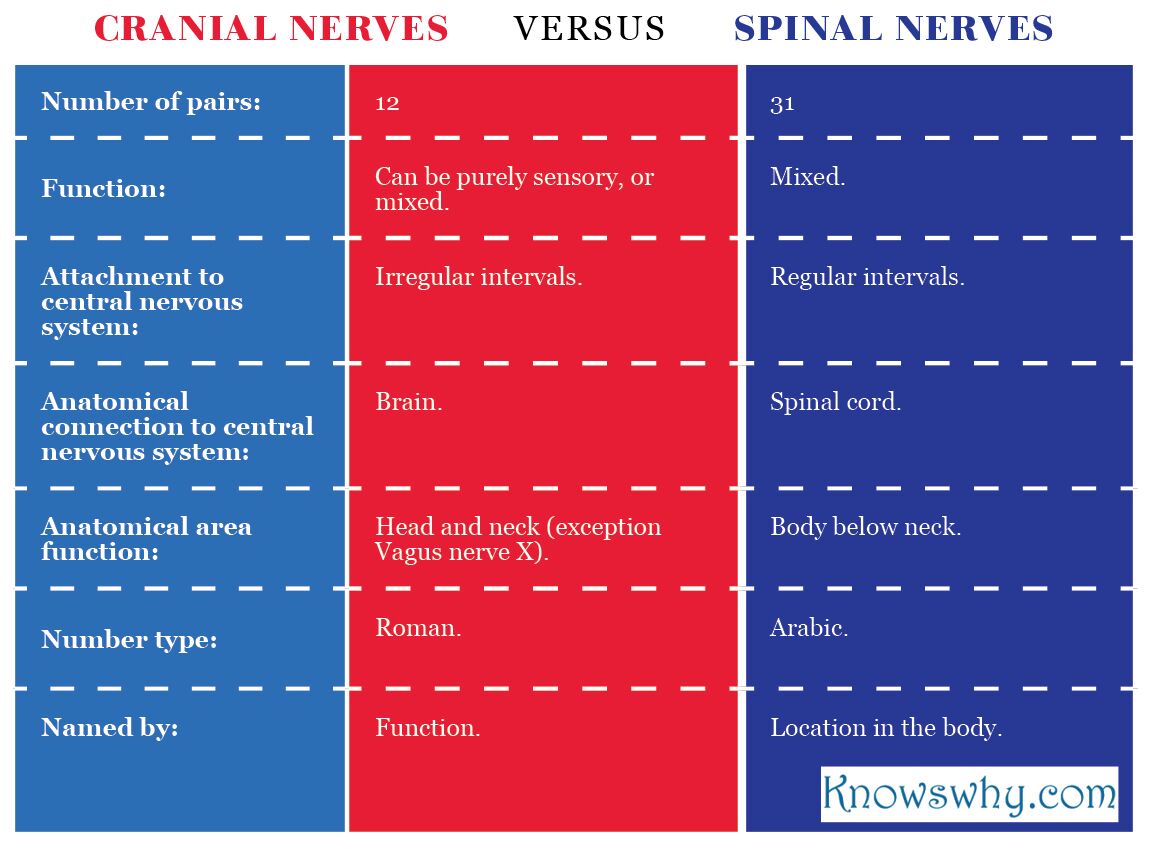




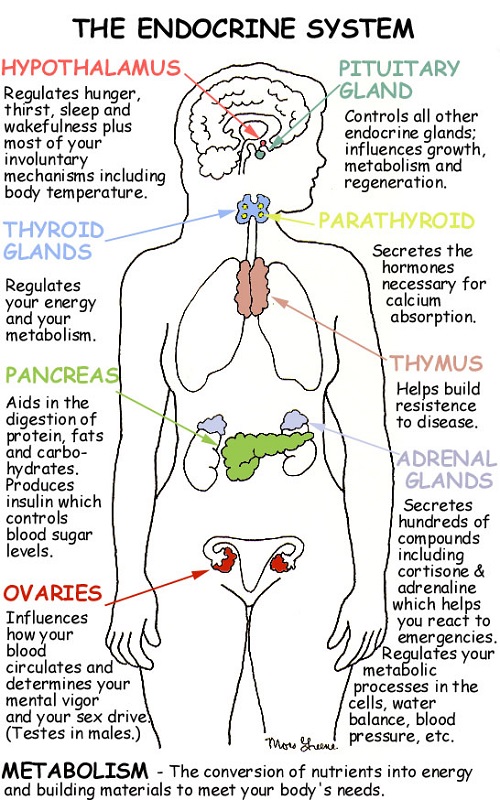
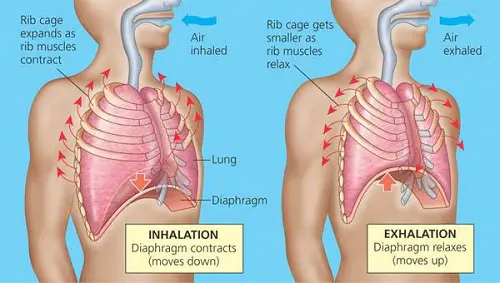





Leave a Reply